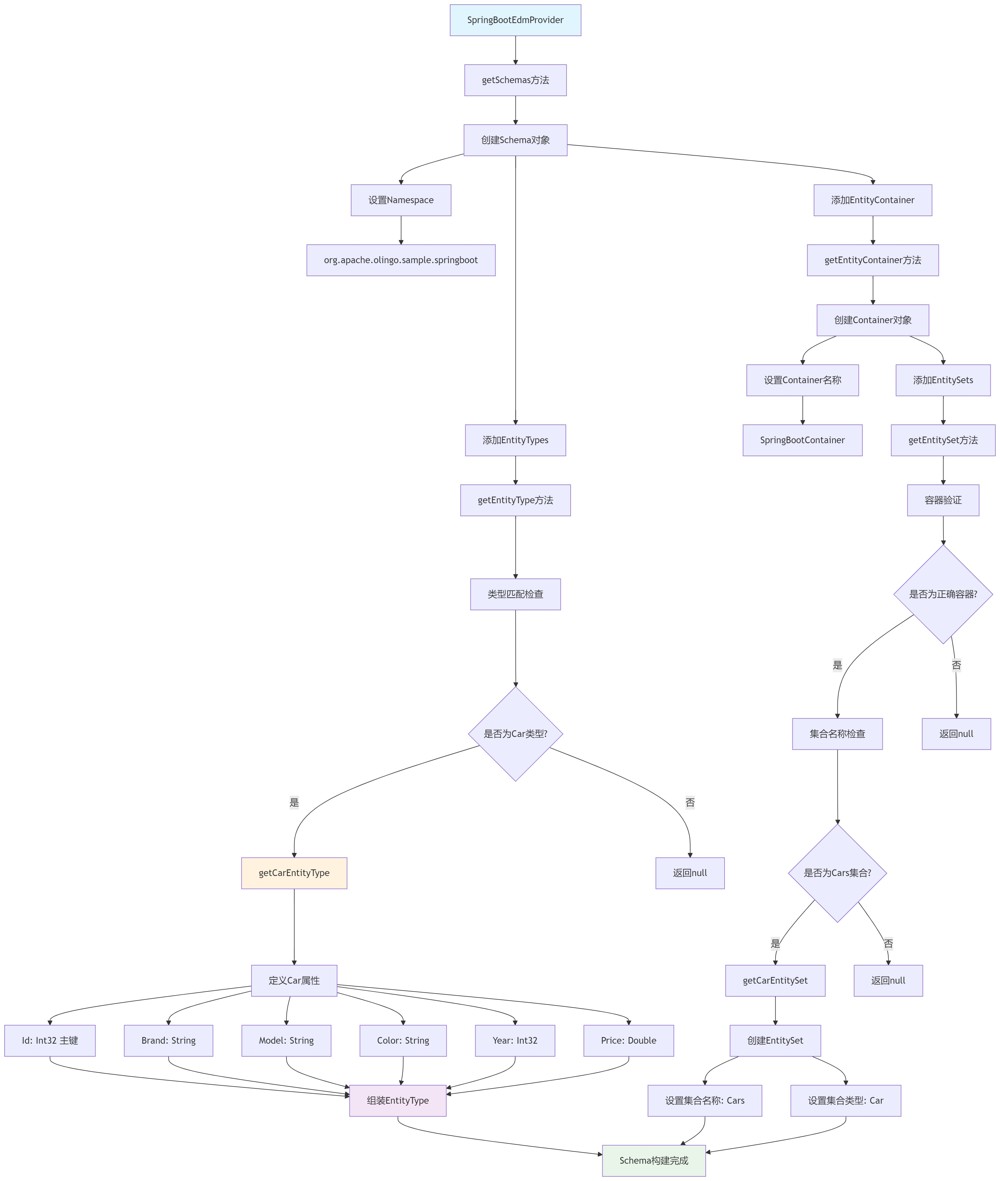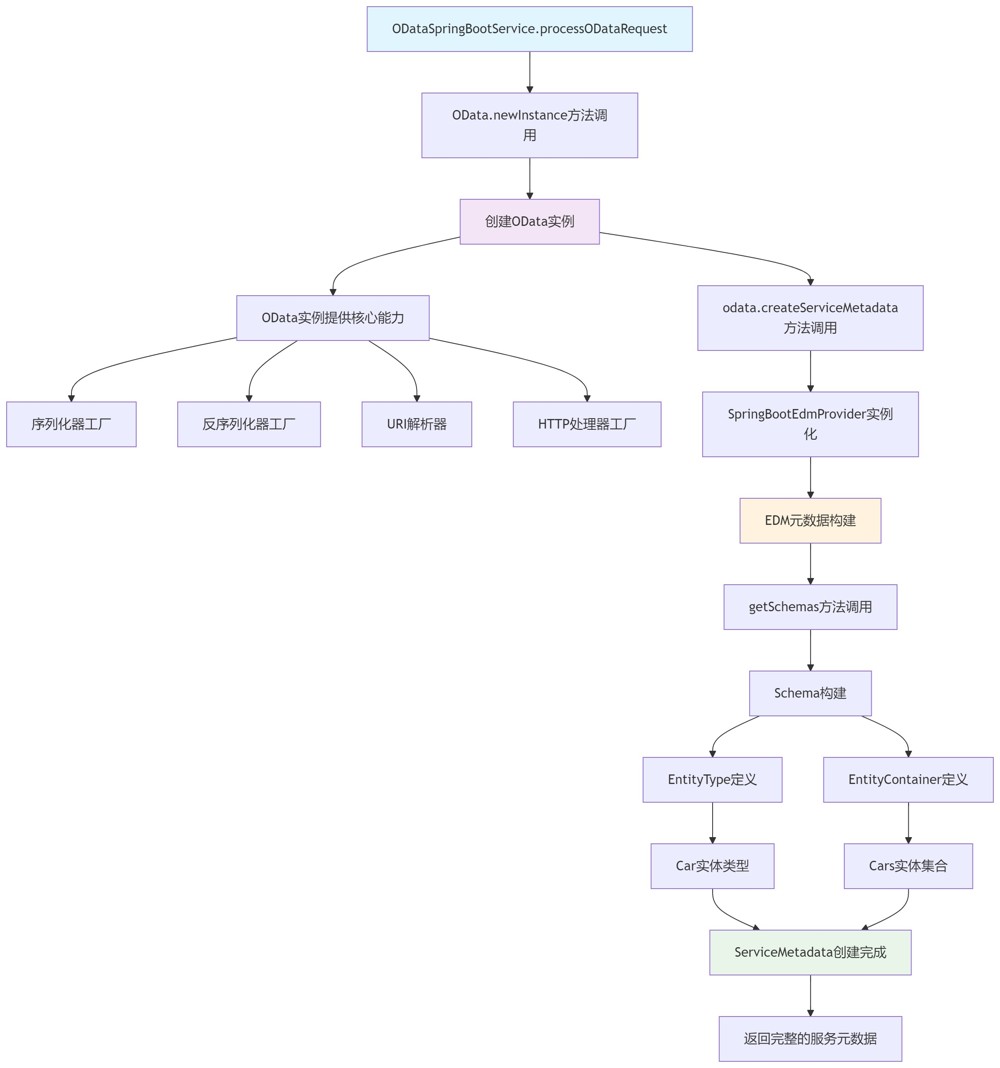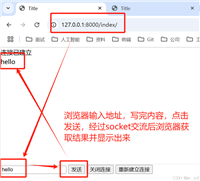概述
在odataspringbootservice.processodatarequest()方法中,odata框架核心组件初始化是整个请求处理流程的关键步骤。这个过程包含两个核心组件的创建:odata实例和servicemetadata服务元数据。
// odata framework initialization - same pattern as carsservlet
odata odata = odata.newinstance();
servicemetadata servicemetadata = odata.createservicemetadata(
new springbootedmprovider(),
new arraylist<>()
);第一步:odata实例创建
1.1 odata.newinstance() 详细分析
odata odata = odata.newinstance();
核心作用:
- 工厂方法模式:通过静态工厂方法创建odata框架的核心入口点
- 单例保证:确保odata实例的统一性和资源管理
- 框架初始化:初始化apache olingo odata框架的核心组件
内部机制:
// apache olingo框架内部实现逻辑(简化版)
public static odata newinstance() {
return new odataimpl();
}
提供的核心能力:
1.1.1 序列化器工厂
// json序列化器 odataserializer jsonserializer = odata.createserializer(contenttype.json); // xml序列化器 odataserializer xmlserializer = odata.createserializer(contenttype.application_xml); // atom序列化器 odataserializer atomserializer = odata.createserializer(contenttype.application_atom_xml);
1.1.2 反序列化器工厂
// 请求体反序列化 odatadeserializer deserializer = odata.createdeserializer(contenttype.json);
1.1.3 uri解析器
// odata uri解析和验证 uriinfo uriinfo = odata.createurihelper().parseuri(uri, servicemetadata);
1.1.4 http处理器工厂
// http请求处理器创建 odatahttphandler handler = odata.createhandler(servicemetadata);
第二步:servicemetadata服务元数据创建
2.1 createservicemetadata() 方法分析
servicemetadata servicemetadata = odata.createservicemetadata(
new springbootedmprovider(), // edm提供者
new arraylist<>() // 引用列表
);
参数详解:
2.1.1 springbootedmprovider - 实体数据模型提供者
核心职责:
- 定义odata服务的数据结构(schema)
- 描述实体类型(entitytype)
- 配置实体集合(entityset)
- 建立实体容器(entitycontainer)
继承关系:
springbootedmprovider extends csdlabstractedmprovider
2.1.2 引用列表 - new arraylist<>()
作用:
- 用于复杂场景下的元数据引用管理
- 支持跨服务的元数据引用
- 在简单场景下为空列表
2.2 springbootedmprovider 深度解析

2.2.1 命名空间和标识符定义
public static final string namespace = "org.apache.olingo.sample.springboot"; public static final string container_name = "springbootcontainer"; public static final fullqualifiedname container = new fullqualifiedname(namespace, container_name); // 实体类型 public static final string et_car_name = "car"; public static final fullqualifiedname et_car_fqn = new fullqualifiedname(namespace, et_car_name); // 实体集合 public static final string es_cars_name = "cars";
设计意义:
- 全局唯一性:通过命名空间避免名称冲突
- 类型安全:使用fullqualifiedname确保类型引用正确
- 可维护性:集中管理所有标识符常量
2.2.2 核心方法实现分析
a. getentitytype() - 实体类型定义
@override
public csdlentitytype getentitytype(fullqualifiedname entitytypename) throws odataexception {
if (entitytypename.equals(et_car_fqn)) {
return getcarentitytype();
}
return null;
}执行流程:
- 类型匹配:检查请求的实体类型是否为car
- 委托处理:调用私有方法构建具体的实体类型
- 返回结果:返回完整的csdl实体类型定义
car实体类型的详细构建:
private csdlentitytype getcarentitytype() {
// 1. 定义属性
csdlproperty id = new csdlproperty().setname("id")
.settype(edmprimitivetypekind.int32.getfullqualifiedname());
csdlproperty brand = new csdlproperty().setname("brand")
.settype(edmprimitivetypekind.string.getfullqualifiedname());
csdlproperty model = new csdlproperty().setname("model")
.settype(edmprimitivetypekind.string.getfullqualifiedname());
csdlproperty color = new csdlproperty().setname("color")
.settype(edmprimitivetypekind.string.getfullqualifiedname());
csdlproperty year = new csdlproperty().setname("year")
.settype(edmprimitivetypekind.int32.getfullqualifiedname());
csdlproperty price = new csdlproperty().setname("price")
.settype(edmprimitivetypekind.double.getfullqualifiedname());
// 2. 定义主键
csdlpropertyref propertyref = new csdlpropertyref();
propertyref.setname("id");
// 3. 组装实体类型
csdlentitytype entitytype = new csdlentitytype();
entitytype.setname(et_car_name);
entitytype.setproperties(arrays.aslist(id, brand, model, color, year, price));
entitytype.setkey(collections.singletonlist(propertyref));
return entitytype;
}属性映射对照表:
| 属性名 | odata类型 | java类型 | 说明 |
|---|---|---|---|
| id | int32 | integer | 主键,唯一标识 |
| brand | string | string | 品牌名称 |
| model | string | string | 车型型号 |
| color | string | string | 颜色信息 |
| year | int32 | integer | 生产年份 |
| price | double | double | 价格信息 |
b. getentityset() - 实体集合定义
@override
public csdlentityset getentityset(fullqualifiedname entitycontainer, string entitysetname) throws odataexception {
if (entitycontainer.equals(container)) {
if (entitysetname.equals(es_cars_name)) {
return getcarentityset();
}
}
return null;
}执行逻辑:
- 容器验证:确认请求来自正确的实体容器
- 集合匹配:检查实体集合名称是否为"cars"
- 构建集合:创建car实体集合定义
实体集合构建:
private csdlentityset getcarentityset() {
csdlentityset entityset = new csdlentityset();
entityset.setname(es_cars_name); // 集合名称:cars
entityset.settype(et_car_fqn); // 集合类型:car实体类型
return entityset;
}
c. getentitycontainer() - 实体容器定义
@override
public csdlentitycontainer getentitycontainer() throws odataexception {
// 创建实体容器
csdlentitycontainer entitycontainer = new csdlentitycontainer();
entitycontainer.setname(container_name);
// 添加实体集合
list<csdlentityset> entitysets = new arraylist<>();
entitysets.add(getentityset(container, es_cars_name));
entitycontainer.setentitysets(entitysets);
return entitycontainer;
}容器作用:
- 集合管理:管理所有实体集合
- 服务入口:作为odata服务的根容器
- url映射:建立url路径与实体集合的映射关系
d. getschemas() - 模式定义
@override
public list<csdlschema> getschemas() throws odataexception {
list<csdlschema> schemas = new arraylist<>();
csdlschema schema = new csdlschema();
schema.setnamespace(namespace);
// 添加实体类型
list<csdlentitytype> entitytypes = new arraylist<>();
entitytypes.add(getentitytype(et_car_fqn));
schema.setentitytypes(entitytypes);
// 添加实体容器
schema.setentitycontainer(getentitycontainer());
schemas.add(schema);
return schemas;
}模式结构:
schema: org.apache.olingo.sample.springboot
├── entitytypes
│ └── car (id, brand, model, color, year, price)
└── entitycontainer: springbootcontainer
└── entitysets
└── cars -> car
2.3 servicemetadata的内部构建过程
2.3.1 元数据验证
servicemetadata servicemetadata = odata.createservicemetadata(edmprovider, references);
内部验证步骤:
- 模式验证:检查edm模式的完整性和一致性
- 类型检查:验证所有实体类型定义的正确性
- 引用解析:处理跨模式的引用关系
- 约束检查:验证主键、外键等约束定义
2.4 生成的元数据结构
2.4.1 $metadata端点响应示例
当访问 http://localhost:8080/cars.svc/$metadata 时,会返回:
<?xml version="1.0" encoding="utf-8"?>
<edmx:edmx version="4.0" xmlns:edmx="http://docs.oasis-open.org/odata/ns/edmx">
<edmx:dataservices>
<schema namespace="org.apache.olingo.sample.springboot"
xmlns="http://docs.oasis-open.org/odata/ns/edm">
<!-- 实体类型定义 -->
<entitytype name="car">
<key>
<propertyref name="id"/>
</key>
<property name="id" type="edm.int32"/>
<property name="brand" type="edm.string"/>
<property name="model" type="edm.string"/>
<property name="color" type="edm.string"/>
<property name="year" type="edm.int32"/>
<property name="price" type="edm.double"/>
</entitytype>
<!-- 实体容器定义 -->
<entitycontainer name="springbootcontainer">
<entityset name="cars" entitytype="org.apache.olingo.sample.springboot.car"/>
</entitycontainer>
</schema>
</edmx:dataservices>
</edmx:edmx>2.4.2 服务文档结构
访问 http://localhost:8080/cars.svc/ 时的服务文档:
{
"@odata.context": "$metadata",
"value": [
{
"name": "cars",
"kind": "entityset",
"url": "cars"
}
]
}
错误处理和调试
1. 常见错误类型
1.1 edm提供者错误
// 错误示例:实体类型未定义
@override
public csdlentitytype getentitytype(fullqualifiedname entitytypename) {
// 忘记实现返回null,导致"entity type not found"错误
return null;
}
1.2 类型不匹配错误
// 错误示例:类型引用错误
csdlproperty id = new csdlproperty().setname("id")
.settype(edmprimitivetypekind.string.getfullqualifiedname()); // 应该是int32
总结

odata框架核心组件初始化是整个odata服务的基础,它完成了以下关键任务:
- 框架初始化:创建odata核心实例,提供序列化、uri解析等基础能力
- 元数据构建:通过edm提供者定义完整的数据模型结构
- 服务配置:建立url路径与数据操作的映射关系
- 类型系统:建立强类型的实体定义和验证机制
这个过程为后续的http处理器创建和请求处理奠定了坚实的基础,是odata服务能够正确响应各种请求的前提条件。
参考代码
到此这篇关于olingo分析和实践之odata框架核心组件初始化的文章就介绍到这了,更多相关olingo odata框架内容请搜索代码网以前的文章或继续浏览下面的相关文章希望大家以后多多支持代码网!






发表评论